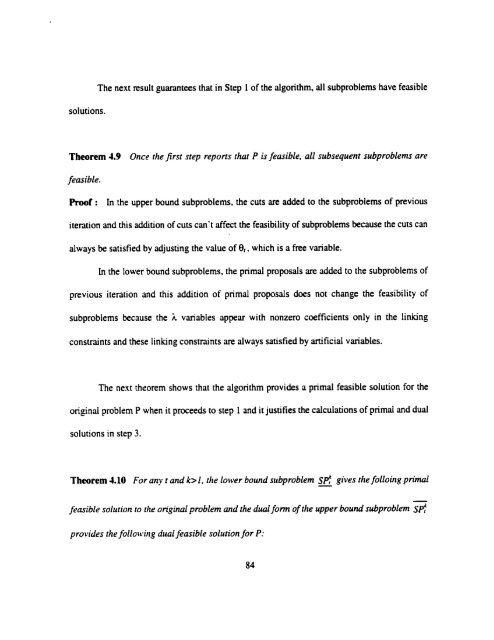X - UWSpace - University of Waterloo
X - UWSpace - University of Waterloo
X - UWSpace - University of Waterloo
You also want an ePaper? Increase the reach of your titles
YUMPU automatically turns print PDFs into web optimized ePapers that Google loves.
solutions.<br />
The next result guanntees that in Step 1 <strong>of</strong> the algorithm. al1 subproblems have feasible<br />
Theorem 4.9 Once the Prst step reporrs that P is feasible. al1 subsequent subproblems are<br />
feasible.<br />
Pro<strong>of</strong> : In the upper bound subproblems, the cuts are added to the subproblems <strong>of</strong> previous<br />
itention and this addition <strong>of</strong> cuts can't affect the feasibiiity <strong>of</strong> subproblems because the cuts cm<br />
always be satisfied by adjusting the value <strong>of</strong> €4. which is a free variable.<br />
In the lower bound subproblems. the primal proposais are added to the subproblems <strong>of</strong><br />
previous itention and ihis addition <strong>of</strong> primal proposais does not change the feasibility <strong>of</strong><br />
subproblems because the A variables appear with nonzero coefficients only in the Iinking<br />
constraints and these linking constraints are dways satisfied by ani ficial variables.<br />
The next throrem shows that the algorithm provides a primal feasible solution for the<br />
original problem P when it pmceeds to step 1 and it justifies the calculations <strong>of</strong> primal and dual<br />
solutions in step 3.<br />
Theorem 4.10 For any t and k>l. the huer bound subproblem - S& gives rhr folloing phal<br />
-<br />
feasiblc soiurion ro rlte original problem and the duai form <strong>of</strong> the upper bound subproblem SP!<br />
provides the folioicing duai feasible solurion for P:
















